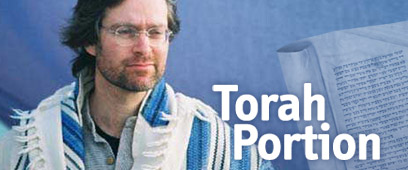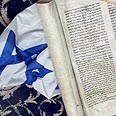

'There is an objective notion of right and wrong'
Photo: Reuters
One of the great questions which confront every human being – whether religious or secular is –what is the relationship between good and evil. There are two basic spiritual approaches to the relationship between good and evil. Whether we realize it or not, the approach that we choose shapes more of our collective and personal lives more then virtually any other issue.
This is the basic issue in this week’s Parshat Hahshavua, which tells the story of Moses coming to Pharaoh to inflict the remainder of the 10 plagues on Egypt as well as the dramatic story of the Exodus of the Israelites from Egypt. Within this Parsha both of these approaches to good and evil are contained. One is the revealed position and reflects the general approach of Biblical consciousness to good and evil. The second position is hidden in the Parsha and represents the general approach of the Kabbalah to good and evil.
The first position argues against the position of moral relativism which is so rampant in the more superficial bastions of modern society.
Moral relativism suggests that no moral position is better then any other position. Moses and Pharoh, light and darkness, Israel and Egypt are all fundamentally equal; there is not way according to this position to ever judge anything; indeed the worst accusation which a moral relativist can level against a person is "you are being judgmental".
In Jewish thought however the most central idea is that there is an objective notion of right and wrong. We might not always know what is right and wrong. However the very existence of God as the ultimate source of all existence and all morality guarantees at least the possibility of establishing that at least some very basic things are objectively good and others are objectively evil.
This is precisely what our Parsha seeks to do when it sets up very sharp distinction between Moses and Pharaoh, Israelites and Egyptians, light and darkness and more.
The god of the bible is a god of moral distinctions and judgment. It was in this regard that Dostoyevsky wrote, "without God all is permitted". He means to say that if there is only the finite, the natural and physical; if there is no sense of the infinite, the supernatural and the metaphysical; that is to say if there is no God, then right and wrong are in the end simply a matter of personal preference.
It was in light of this understanding that the great philosopher George Bertrand Russel said, “the only problem with my atheism is that I cannot believe that the only thing wrong with mass murder is that I do not like it".
This level of consciousness which is based on the ability to make at least the most fundamental distinction between good and evil is called by the Baal Shem Tov, Havdalah. Fairly soon we will begin to hear voice on the Israeli scene who will begin to make moral comparisons between Israel and Hamas. It is just a matter of time. We will hear comparisons between the Irgun and Hamas and the like.
‘Unconscious evil’
We need to remember that there is a fundamental distinction between Israeli society which is based on a universal sense of human rights and justice, in which the overwhelming majority of it's citizen deplore terror – and the Palestinian population including that of East Jerusalem which voted to embrace an organization that has made suicide bombers and the most vile forms of terrorism a central tenet of it's philosophy.
However, the sharp division between good and evil is not the whole story. There is a second philosophy of good and evil hidden in this week’s Parsha. This position was called by the Baal Shem Tov Hamtaka. According to the Zohar on this week's Parsha, in Havdalah consciousness we say "greater is the light then the darkness". However In hamtaka consciousness we say "Greater is the light that comes from the darkness."
The kabbalists all point out that our parsha should begin with a command from God to Moses, "Go to Pharaoh for I have hardened his heart". Instead the text reads "God said to Moses, Come to Pharaoh. The kabbalists in a deep reading of the verse realize that God is saying to Moses, come, meaning come to me. And where is God? In Pharoh. Says God to Moses, and we are all Moses, "I am waiting for you in the heart of Pharaoh". The last phrase in the verse, "Hichbadti et Libo" is read by the kabbalists not as, "I hardened his heart" but as "my Kavod, my glory, is inside the heart of Pharaoh.”
Sometimes we need to look in our darkness to find God. Good and evil at the level of consciousness which the Baal Shem calls Hamtaka, are not as distinct as we first thought. There is light within the darkness and good within evil.
This is the same idea expressed in the secret of the Gold. There are four stories of the gold that form part of the textual source code of the book of exodus that all revolve this issue. In our Parsha Israel leave Egypt with the gold of Egypt. They borrow the gold from their Egyptian neighbors and take it with them on their journey of redemption.
This gold is understood by the kabbalists to represent what psychologist Jung would call the Shadow. Shadow means any quality good or bad remains in the unconscious. The gold is stolen by the Jews from the Egyptians. No one however seems to notice that it was stolen. It is unconscious evil. Indeed in the self experience of the Jews they were actually commanded by God to take the gold with them. However the text adds on a telling phrase to teach us that this story is more complex then it might seem at first glance. "They borrow from the Egyptians vessels of Gold and silver...They despoiled Egypt." "Vayenatzlu Et Mitzrayim."
‘It is not enough to take the gold off’
Unconscious shadow qualities always remain dormant as long as everything in our lives is okay. However when things go wrong the shadow of gold comes roaring out of the fire. This is the second gold story of the book of exodus. Moses does not come down from mountain of Sinai at the time they were expecting him. Moses represents the people's sense of safety and security. When he disappears the people feel vulnerable. So they make a golden calf. Where did the gold come from? Of course the golden calf – the great sin of the Israelites in the desert- is made from the gold they took with them from Egypt.
The third meeting with the gold appears when the Israelites – trying to heal the sin of the Golden calf- take off their gold jewelry as a sign of remorse over the golden calf. "Israel took of their gold ornaments which they wore at the Mountain of Horeb". Adi in this context means a gold ornament. The word for "took off" which is used in the text is Vayitnatzlu. Clearly this is the closing of a circle. When they took the gold the text said Vayenatzlu. Now that they take off the gold the text says, Vayitnazlu.
This third story is about the necessary for discipline in dealing with shadow. However this is not yet the end of the story. The fourth story of gold is the story of the tabernacle and its sacred vessels – which according to the text were primarily made of Gold. The point is very powerful. It is not enough to take the gold off. This is an act of Havdalah. In Havdalah consciousness the human being says, let me separate myself from the Gold which represents shadow and evil.
‘We completely reject Hamas' version of holiness, spirit’
However in the fourth gold story, this very gold is used to build the holy tabernacle. This stage of consciousness is teaching the integration of shadow. It is only by integrating the shadow that one can build a tabernacle.
So we need to ask ourselves a hard question. Of course on the level of havdalah consciousness there are critical moral distinctions between us and the Hamas which must remember clearly and not fall pray to moral relativism. On the other hand we need to ask ourselves; is there anything about Hamas that represent part of our people that has fallen into shadow. I would suggest that in Shadow terms, Hamas represents a level of commitment and connection to spirit that much of the Israeli population has lost. It is true that we do not fight holy wars.
But is that because we are so good- or is it because we do have forgotten that there is something called holiness which is worth fighting for. Hamas is indeed evil in many ways. However Hamas may also represent the collective shadow of much of Israeli society which has become lazy and superficial and lost its connection to the land, to spirit, to self sacrifice and to commitment.
Of course we completely and totally reject Hamas' version of holiness and spirit. It is only however reclaiming and integrating our own sense our sense of holiness and spirit into the fabric of our lives that we can rebuild the Mishkan of vision and commitment which makes Zionism a holy enterprise and not an outdated, racist nationalist enterprise.
Rabbi Mordechai Gafni - Teacher and student of Torah; Leader of Bayit Chadash Spiritual Community and Movement; Chair of Integral Kabbalah at Integral Institute of Ken Wilber
The "Bayit Chadash" website: www.bayitchadash.org















